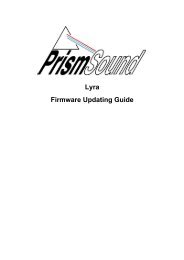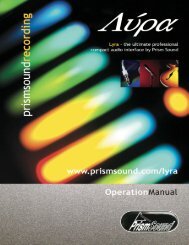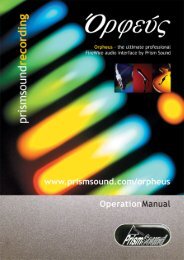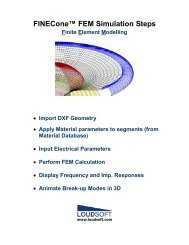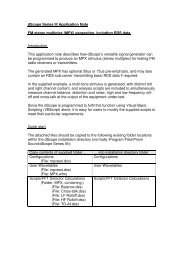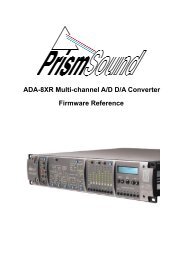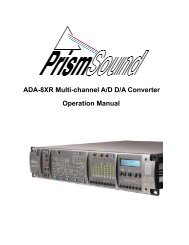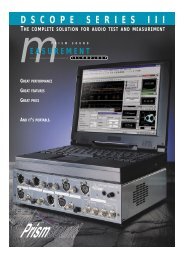ADA-8XR Multi-channel A/D D/A Converter Operation Manual
ADA-8XR Multi-channel A/D D/A Converter Operation Manual
ADA-8XR Multi-channel A/D D/A Converter Operation Manual
You also want an ePaper? Increase the reach of your titles
YUMPU automatically turns print PDFs into web optimized ePapers that Google loves.
Prism Sound <strong>ADA</strong>-<strong>8XR</strong> <strong>Multi</strong>-<strong>channel</strong> A/D D/A <strong>Converter</strong> <strong>Operation</strong> <strong>Manual</strong> - Revision 1.00<br />
5.3 Monitor Panel<br />
The Monitor Panel controls the <strong>ADA</strong>-<strong>8XR</strong>’s two-<strong>channel</strong><br />
monitor.<br />
The Monitor drives both analogue and digital line outputs,<br />
which are situated on the Utility Panel on the rear of the<br />
unit. The analogue outputs also drive a headphone<br />
socket on the front. For further details see the Utility<br />
Module section in the I/O Modules section.<br />
The Monitor can be fed from either Path 1 or Path 2, as<br />
selected by the ‘Path’ selector button, either pre- or postthe<br />
Path’s processing section (where available) as<br />
selected by the ‘Pre Post’ button. Note that the audio<br />
output of the Monitor is controlled directly by these<br />
buttons; the equivalent buttons on other Panels only<br />
assign the Panels’ display.<br />
The ‘Cut’ button mutes the Monitor, its LED flashing red to<br />
indicate the muted state. The ‘Invert’ button phase-inverts<br />
BOTH of the Monitor’s output <strong>channel</strong>s when the orange LED is lit. The ‘Mono’ button causes<br />
the two Monitor <strong>channel</strong>s to be mixed together at both outputs when its LED is lit. The ‘Swap’<br />
button exchanges the Monitor’s A and B <strong>channel</strong> outputs when its LED is lit.<br />
A volume control is available if required, although this can be defeated from within the Monitor<br />
options menus.<br />
The blue Access button at the top of the panel causes the menu system to enter a small<br />
range of menus which apply to the two-<strong>channel</strong> Monitor. These menus control various<br />
auxiliary functions such as analogue line-up level, headphone-cut, volume control<br />
enable/disable etc., as well as allowing selection of the Monitor operating mode:<br />
In ‘Pairs’ mode, the adjacent-<strong>channel</strong> pairs are monitored, whereas in ‘Mixed’ mode, a mix of<br />
any of the Path’s <strong>channel</strong>s can be created, each with its own gain and pan setting. Separate<br />
mixes are retained for each Path, which are selected when that Path is monitored.<br />
For full details of the Monitor-related menus, see the Firmware Reference.<br />
© Prism Media Products Limited, 2001-2004 Page 1.21




